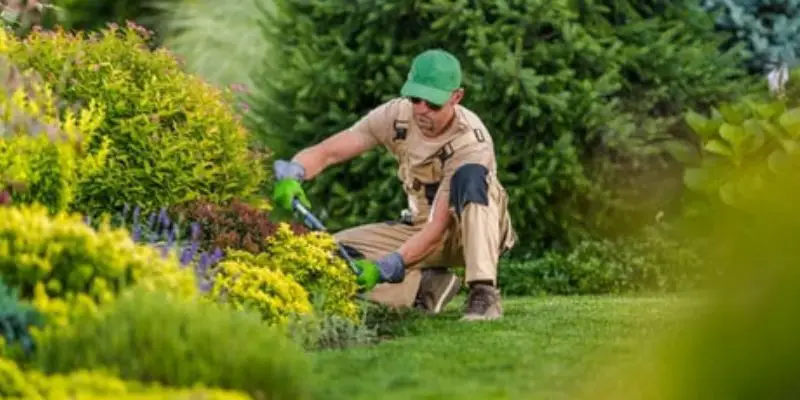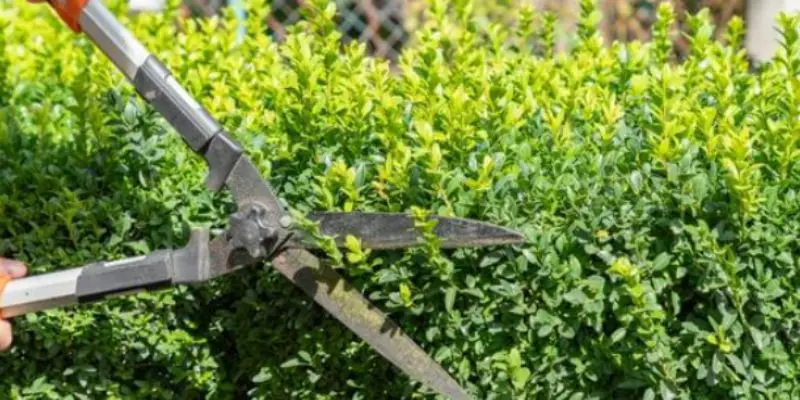Ever wondered why your bushes sometimes look overgrown or lackluster? The secret lies in timing your trimming just right. Proper bush maintenance is key to keeping your shrubs looking their best and promoting lush, vibrant growth. Are you wondering when to trim bushes? That’s the million-dollar question, and the answer can vary depending on factors like the bush type, your climate, and what you’re trying to achieve.
In this comprehensive guide, you’ll discover the importance of proper timing for bush trimming and get an overview of the different factors that influence when to reach for those pruning shears. By the end, you’ll have a solid understanding of how to keep your bushes looking their best year-round.
Your bushes will thank you for taking the time to learn these tips and tricks. After all, a well-timed trim can mean the difference between a thriving, beautiful landscape and a scraggly, overgrown mess.
Importance of Proper Timing for Bush Maintenance
Trimming your bushes at the wrong time can seriously impact their health and appearance. Pruning too early or too late can stunt growth, reduce flowering, or even damage the plant. That’s why understanding the right timing is so crucial.
Picture this: you lovingly trim your flowering bushes in late summer, only to find they barely bloom the following spring. Or imagine putting in all that hard work pruning your evergreens, just to have them looking sparse and unhealthy a few months later. Proper timing can help you avoid these disappointing scenarios and keep your bushes looking their best.
When to Trim Bushes: Overview of Factors Influencing Trimming Schedules
When it comes to timing your bush trimming, there’s no one-size-fits-all solution. The optimal time to prune depends on factors like the bush type, its growth habits, your climate, and even your goals for the plant.
Best Cordless Battery Hedge Trimmers – Top 7 Reviews and Buying Guide
Are you aiming for maximum flowering, or are you more focused on controlling growth and maintaining a neat shape? Do you live in a region with harsh winters or mild year-round temperatures? These are all important considerations that will influence when you should break out the pruning shears.
Understanding Seasonal Trimming Cycles
As the seasons change, so do the needs of your bushes. Timing your trimming efforts to align with these natural cycles is key to keeping your shrubs healthy and thriving.
Spring Trimming:
When the world comes alive again after a long winter’s slumber. For many types of bushes, this is prime pruning season. As your plants emerge from dormancy, a well-timed trim can encourage new growth and help shape their form for the coming year.
That said, you’ll want to be careful not to prune too early. A late frost can spell disaster for freshly pruned stems. Generally, the sweet spot for spring trimming is just as those buds start to swell – a sure sign that active growth is about to begin.
Summer Pruning:
Once summer rolls around, your trimming focus may shift from shaping to controlling growth and maintaining that neat, tidy look you worked so hard to achieve in spring. For flowering shrubs, it’s generally best to prune after the blooms have faded to avoid sacrificing next year’s floral display.
Evergreen bushes, on the other hand, may require some light trimming during the summer months to keep them looking sharp. Just be sure not to go overboard – a little pruning goes a long way when it comes to these hardy plants.
Fall Maintenance:
As the leaves start to turn and the air grows crisp, it’s time to start thinking about preparing your bushes for their long winter’s nap. Fall pruning is all about removing any dead or damaged branches, as well as thinning out dense growth to improve air circulation.
But beware of pruning too late in the season! This can encourage new growth that may not have time to harden off before Jack Frost comes knocking. Aim to have your fall trimming wrapped up well before the first hard freeze for best results.
When to Trim Rose Bushes
Ah, the rose – perhaps the most beloved and iconic of all flowering bushes. Proper pruning is essential to keeping these beauties healthy and prolific, but timing is everything.
Ideal Months for Pruning Rose Bushes
For most rose varieties, the ideal time to break out the pruning shears is in late winter or early spring, just before those buds start to swell. This encourages vigorous new growth and sets the stage for an abundant bloom later in the season.
Top 5 Best Black and Decker Cordless Hedge Trimmer Reviews
Of course, there are always exceptions to the rule. Certain rose varieties, like climbers or once-blooming types, may have slightly different pruning schedules. Be sure to do your research and follow variety-specific recommendations for best results.
Tailoring Trimming Techniques to Rose Varieties
Speaking of variety-specific considerations, the way you prune your roses can also vary depending on the type. Some, like hybrid teas and floribundas, benefit from a more aggressive annual pruning to promote new cane growth and flowering.
Others, like shrub roses, prefer a lighter touch. Heavy pruning on these varieties can actually reduce their floral display. Always take the time to understand your particular rose’s needs before reaching for those pruners.
When to Trim Lilac Bushes
Few things are as enchanting as a lilac bush in full, fragrant bloom. But to ensure those intoxicating purple (or white!) clusters return year after year, you’ll need to master the art of properly timed pruning.
Timing Pruning to Maximize Flowering Potential
Here’s a pruning pro tip for you: the ideal window for trimming lilac bushes is right after they finish blooming in late spring or early summer. Pruning at this time allows the plant to set new flower buds for next year’s showy display.
Miss this prime window, and you risk removing those all-important buds before they have a chance to form. No buds means no blooms – and a very disappointing spring in your lilac patch.
Avoiding Common Mistakes When Pruning Lilacs
One of the most frequent lilac pruning pitfalls? Waiting too long after the blooming period to do your trimming. Prune in late summer or fall, and you could be inadvertently removing all those newly formed buds, leaving you with a flowerless bush come spring.
Overpruning can also take a toll on these shrubs, stressing them out and reducing their overall vigor. The name of the game with lilacs is a light, strategic trim timed just right.
When to Trim Crape Myrtle Trees
With their showy summer blooms and gorgeous peeling bark, crape myrtles are a landscape staple across much of the country. But those stunning good looks require some strategic timing when it comes to pruning.
Best Times of Year to Prune Crape Myrtle Trees
For crape myrtles, late winter or early spring is generally considered prime pruning time. Aim to get your trimming done just before those first new leaves start to unfurl.
Pruning at this time allows you to remove any dead or damaged branches and sculpt that classic multi-trunked form, all without sacrificing the upcoming season’s floral display. It’s a win-win!
Best Electric Hedge Shears – Top 6 Reviews and Buying Guide
Pruning Techniques for Enhancing Crape Myrtle Growth and Form
But timing isn’t the only consideration when pruning crape myrtles. Proper technique is also key to promoting healthy growth and maintaining that coveted shape.
This may include thinning out the interior branches to improve air flow, removing any unsightly suckers or water sprouts, and selectively pruning to accentuate that naturally gorgeous multi-trunked silhouette. With the right touch, you can help these trees put their best trunk forward.
When to Prune Butterfly Bushes for Health and Vigor
If you love attracting pollinators to your yard, chances are you have at least one butterfly bush gracing your landscape. These vibrant bloomers are a surefire way to bring in the butterflies – but only if you prune them at just the right time.
Seasonal Considerations for Butterfly Bush Maintenance
Late winter or early spring is typically the prime window for giving your butterfly bushes their annual pruning. This allows you to remove any dead or damaged canes and thin out the interior for improved air flow and light penetration.
But don’t stop there! For continuous blooms all season long, you’ll want to deadhead (remove spent flower spikes) periodically throughout the growing season. This helps redirect the plant’s energy toward producing more of those irresistible purple pom-pom flowers.
Promoting Healthy Growth and Flowering with Proper Pruning
Proper pruning doesn’t just keep your butterfly bush looking its best – it’s also essential for promoting vigorous growth and consistent flowering.
By thinning out overcrowded branches and deadheading diligently, you improve air circulation and light exposure while also preventing the plant from expending precious resources on setting seed. The result? A bush that stays healthier and continues pumping out those butterfly-attracting blooms all summer long.
Guidelines for Trimming Various Types of Shrubs
From classic evergreen foundations to flowering accent shrubs, the variety of bushes found in typical residential landscapes is vast. And just as each one brings its own unique beauty, so too do they have varying pruning needs and ideal timing.
General Principles for Timing Shrub Pruning That said, there are some general guidelines that apply to most shrub types when it comes to timing trims. For the majority of bushes, late winter or very early spring tends to be prime pruning time.
This window, just before active growth kicks into high gear, allows you to shape up your shrubs and remove any dead or damaged wood without impacting the upcoming season’s display. It’s the sweet spot for giving your bushes a fresh start.
Adjusting Trimming Schedules Based on Specific Shrub Characteristics
Of course, you’ll want to take things a step further and consider the specific characteristics and needs of your individual shrub varieties. Spring-bloomers, for example, are usually best pruned right after flowering to avoid removing next year’s buds.
Evergreens may require lighter but more frequent trimming to maintain their crisp appearance. And shrubs with ornamental bark or unique growth habits could have their own customized pruning schedules. Do your research, and you’ll be rewarded with healthier, better-looking plants.
Best Electric Bush Trimmers – Top 5 Reviews and Buying Guide
Factors Influencing Trimming Timing
Even armed with the basic seasonal pruning guidelines, there are still several other important factors that can influence exactly when you should plan to trim your bushes. Paying attention to these nuances is key to true pruning mastery.
Understanding Bush Growth Patterns and Dormancy Cycles
Every type of bush has its own unique growth rhythms and dormancy patterns that impact ideal pruning times. Some plants may remain actively growing well into fall, while others start winding down much earlier in preparation for winter’s chill.
Getting to know the specifics of how your bushes grow and rest throughout the year can help you pinpoint those pruning sweet spots for maximum health.
Environmental and Climate Considerations for Timing Pruning
Your local climate and weather patterns can also play a major role in determining the best times for trimming. In regions with extremely cold winters, for instance, you may need to prune earlier in fall to avoid subjecting fresh growth to harsh freezes.
Conversely, gardeners in mild climates may be able to push their pruning later into early spring without risking cold damage. Always consider your area’s typical conditions when scheduling trims.
Signs That Bushes Require Immediate Pruning
While sticking to a regular seasonal pruning schedule is wise for maintaining healthy bushes, there are times when more urgent trimming may be required. Keeping an eye out for these red flags can help you respond quickly and keep issues from escalating.
Recognizing Symptoms of Overgrowth or Damage
An overgrown, unruly bush isn’t just an eyesore – it’s also a prime candidate for problems like disease, insect infestations, and branch damage from excess weight. If your shrubs start to look like a tangled mess, it’s probably time for an immediate pruning session.
The same goes for bushes that have sustained visible damage from storms, heavy snow loads, wildlife, or other mishaps. Prompt removal of broken or compromised branches can prevent further harm and give the plant its best chance at recovery.
Addressing Emergency Pruning Needs to Maintain Bush Health
In severe cases involving disease or extensive damage, emergency pruning may be the only way to save the life of your bush. While never something to take lightly, sometimes aggressive trimming is necessary as a last-ditch effort to remove diseased or hopelessly broken limbs and preserve what’s left of the plant.
If you suspect your bush is suffering from a serious condition, don’t delay – get out those pruners and take action before it’s too late.
Balancing Growth Objectives with Plant Health
When pondering when to trim bushes, it’s about more than just aesthetics. Your pruning schedule should strike a balance between achieving your desired growth outcomes and protecting the overall vigor of your plants.
Achieving Optimal Growth Through Strategic Trimming
For shrubs grown primarily for their flowers, a well-timed trim can be the key to promoting an abundant bloom season. By pruning at just the right time, you remove spent blooms while allowing new buds to form for next year’s show.
If lush, full growth is your goal, trimming can be used to control wayward branches and encourage a dense, compact form. Tailoring your pruning plan to your specific bushes’ needs helps ensure you achieve the exact look you’re after.
Ensuring Bush Resilience and Long-Term Health Through Proper Timing
But chasing those growth objectives shouldn’t come at the expense of your plants’ basic health and resilience. Pruning at the wrong time or with overly aggressive techniques can shock a bush’s system, leaving it vulnerable to disease, insect problems, and environmental stresses.
The key is finding that happy medium – strategically pruning to direct growth while respecting your bushes’ natural cycles and limits. With some planning and care, you can have both beautiful bushes and peace of mind about their hardiness.
Consulting Experts for Timing Advice and Guidance
Even with all the guidance out there, there may be times when you need some extra insight to nail down the perfect pruning schedules for your unique bushes and landscape. That’s when it’s wise to call in the experts for backup.
Seeking Professional Input for Complex Trimming Scenarios
If you’re dealing with rare, valuable, or otherwise tricky plant specimens, consider enlisting the help of a professional arborist or horticulturist. These green-thumbed gurus have the training and experience to develop tailored pruning plans that meet your bushes’ very specific needs.
They can also provide invaluable advice if you’re facing a complex pruning challenge, like renovating a severely overgrown or neglected planting. Why risk making an expensive mistake when the experts are just a call away?
Local Resources and Extension Services for Regional Timing Recommendations
For region-specific pruning intel, your local university extension service or botanical garden can be an amazing resource. The specialists at these organizations are deeply familiar with your area’s climate patterns, pest pressures, and more – all factors that impact ideal trimming times.
They can provide customized trimming schedules tailored to your locale, as well as alert you to any unique regional concerns you’ll want to consider during pruning season. Think of them as your personal pruning meteorologists!
Conclusion: When to Trim Bushes for Optimal Results
There you have it, an in-depth look at when to cut bushes for optimal health, growth, and aesthetics. Clearly, timing is everything when it comes to keeping your landscape’s shrubs looking their best year after year.
As you put together your personal pruning calendar, be sure to account for factors like the specific bush types in your yard, their natural growth cycles, and your local climate patterns. Understanding the role these variables play in ideal trimming times is half the battle.
From there, it’s about striking the right balance between preventing overgrowth, promoting desired characteristics like flowering, and safeguarding your plants’ resilience. With diligent monitoring and a little expert guidance when needed, you can master this delicate dance.
The bottom line? A little proactive pruning planning goes a long way towards keeping your bushes happy, healthy, and looking like a million bucks. So get out there, study up on your shrubs’ specific needs, and put together some trimming schedules that work for both you and your plants.
Your future self – not to mention your curb appeal – will thank you for taking the time to make to trim bushes at the right time more than just an afterthought. Cheers to lush growth, beautiful blooms, and a landscape that makes the neighbors jealous!
Also read:
Best Electric Bush Trimmers – Top 5 Reviews and Buying Guide

Michael Glenn is a certified arborist and horticultural expert with over 15 years of experience in the landscape industry. His passion for plants and trees has led him to become a sought-after authority on pruning and trimming techniques. Glenn’s in-depth knowledge of proper pruning methods, timing, and tools has helped countless homeowners and professionals maintain healthy, aesthetically pleasing gardens and landscapes.
In addition to sharing his pruning expertise through practical tips, step-by-step guides, and expert advice, Glenn is also a respected author of pruning tool buying guides. His comprehensive reviews and comparisons ensure readers can make informed decisions when investing in quality loppers, pruning shears, saws, and other essential equipment. With a deep understanding of plant biology and sustainable practices, Glenn’s writing empowers audiences with the knowledge needed to properly care for green spaces.




